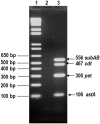Diarrheagenic Escherichia coli carrying supplementary virulence genes are an important cause of moderate to severe diarrhoeal disease in Mexico
- PMID: 25738580
- PMCID: PMC4349884
- DOI: 10.1371/journal.pntd.0003510
Diarrheagenic Escherichia coli carrying supplementary virulence genes are an important cause of moderate to severe diarrhoeal disease in Mexico
Abstract
Diarrheagenic Escherichia coli (DEC) cause acute and persistent diarrhoea worldwide, but little is known about their epidemiology in Mexico. We determined the prevalence of bacterial enteropathogens in 831 children with acute diarrhoea over a four-year period in Yucatan, Mexico. Six DEC supplementary virulence genes (SVG), mainly associated with enteroaggregative E. coli (EAEC), were sought in 3100 E. coli isolates. DEC was the most common bacterial enteropathogen (28%), surpassing Salmonella (12%) and Shigella (9%). Predominant DEC groups were diffusely adherent E. coli (DAEC) (35%), EAEC (24%), and enteropathogenic E. coli (EPEC) (19%). Among children with DEC infections, 14% had severe illness mainly caused by EPEC (26%) and DAEC (18%); 30% had moderate diarrhoea mainly caused by DAEC (36%), mixed DEC infections (33%) and EAEC (32%). DAEC was most prevalent during spring, while ETEC, EAEC and EPEC predominated in summer. EAEC was more frequent in children 6-24 months old than in those younger than 6 months of age (P = 0.008, OR = 4.2, 95% CI, 1.3-13.9). The presence of SVG dispersin, (aatA), dispersin-translocator (aatA), enteroaggregative heat-stable toxin 1 (astA), plasmid encoded toxin (pet), cytolethal distending toxin (cdt) was higher in DEC than non-DEC strains, (36% vs 26%, P <0.0001, OR = 1.5, 95% CI, 1.3-1.8). 98% of EAEC-infected children harboured strains with SVG; 85% carried the aap-aatA gene combination, and 33% of these also carried astA. 28% of both EPEC and ETEC, and 6% of DAEC patients had strains with SVG. 54% of EPEC patients carried pet-positive strains alone or in combination with astA; only this DEC group harboured cdt-positive isolates. All ETEC patients carried astA- or astA-aap-positive strains. astA and aap were the most common SVG in DAEC (3% and 2%) and non-DEC strains (21% and 13%). DEC carrying SVG are an important cause of moderate to severe bacterial diarrhoea in Mexican children.
Conflict of interest statement
The authors have declared that no competing interests exist.
Figures



References
-
- Perfil Epidemiológico de las Enfermedades Infecciosas Intestinales. (2012) Secretaría De Salud. Subsecretaría De Prevención Y Promoción De La Salud. Dirección General De Epidemiología http://ww.epidemiologia.salud.gob.mx/dgae/infoepid/publicaciones2012.
-
- Causas de mortalidad en menores de 1 año y 1–4 años para el 2010 (2012) Secretaría De Salud. Subsecretaría De Prevención Y Promoción De La Salud. Dirección General De Epidemiología: http://www.epidemiologia.salud.gob.mx/doctos/infoepid/publicaciones/2012...
-
- Afset JE, Bergh K, Bevanger L. (2003) High prevalence of atypical enteropathogenic Escherichia coli (EPEC) in Norwegian children with diarrhoea. J Med Microbiol. 52(Pt 11):1015–1019. - PubMed
-
- Cohen MB, Nataro JP, Bernstein DI, Hawkins J, Roberts N, et al. (2005). Prevalence of diarrheagenic Escherichia coli in acute childhood enteritis: a prospective controlled study. J Pediatr 146: 54–61. - PubMed
Publication types
MeSH terms
Grants and funding
LinkOut - more resources
Full Text Sources
Other Literature Sources
Medical
Research Materials
Miscellaneous

